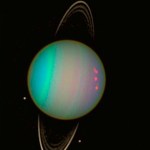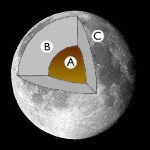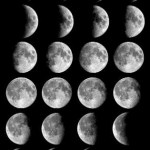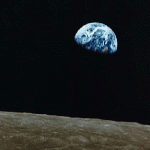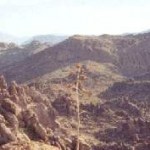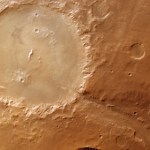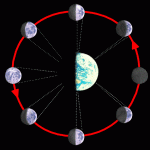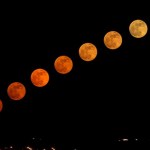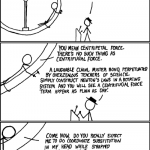Solar System
(This is adapted from my public lecture, Afraid of the Dark: How We Know What We Can't See.)
Let's go back over 200 years ago, to 1781. William Herschel (left) discovered the planet Uranus, noticing that an object, as bright as a star, was actually moving relative to the other stars. The other five inner planets (besides Earth) were known for over 2000 years before that. But it was thought for a long time that Saturn was the farthest one.
But it clearly isn't; as you can see with modern telescopes, Uranus is a super-interesting planet, rotating on its side, surrounded by rings and moons.…
Can you believe that I had a fight today with someone who's been dead for over 350 years, and I'm losing? -- Ethan, yesterday
Of course you can believe it, when the man I'm fighting with is Johannes Kepler. I don't get a chance to tell you about my research very often, mostly because it's still a work in progress. But my latest paper was just submitted and is now out of the way, and so I'd like to tell you what I'm working on at the moment.
Well, there we are in the galaxy. We look up at the night sky, and we see our planets as well as all the stars that surround us. But you know what we don…
But I didn't want one! Stop your whining, Earthlings. We have a serious question to answer, courtesy of Tamara:
What’s the moon like below its surface, moving into the interior? And what’s the current thought on its formation?
Well, we do know a lot about the Moon's insides the same way we know about the Earth's; just like the Earth has earthquakes, the Moon has moonquakes. These tell us about the Moon's interior. From back when we landed on the Moon, we planted the Apollo seismic experiments and saw 28 moonquakes. From these, we learned that the Moon has a crust about 60 km deep, a deep…
And if the band you're in starts playing different tunes
I'll see you on the dark side of the Moon.
One of my favorite readers, Zrinka, asks us why we're only able to see one side of the Moon from Earth. Seriously, look at the different phases; we always see the same side of the Moon:
How does this happen? Well, the Moon makes one revolution around the Earth about every 29 days, and that's what causes the Moon phases. But the Moon also rotates once every 29 days also. Because of this, the same side of the Moon always faces the Earth:
We call this "being locked." We're not the only system…
As you may have noticed from yesterday's unusual post, today is Earth Day! I thought I'd share with you some of my favorite pictures from space of it, including the famous photograph from Apollo 8 known as Earthrise:
This combination shot made from NASA’s Terra satellite and NOAA’s Geostationary Operational Environmental Satellite:
The known satellites at least 0.1 meters in size in orbit around Earth (there are ~11,000 of them as of April 2005, and another 100,000 between 1 cm and 10 cm in size):
Looking at the Earth and the docked Space Shuttle from the International Space Station:
And…
What makes earthquakes? Although there are many causes, including volcanoes, the most common thing that causes them are tectonic motions, which also cause tsunamis. But as valuable as it is to understand other planets in our solar system and in other star systems, sometimes it's important to understand what's going on inside our own planet.
The crust of the Earth actually is made up of a number of plates, which rub against one another and move over time. Who's to blame? I fault the liquid hot magma.
So what happens is that these plates slip against each other in one of three ways, as shown…
...just bring your own air and water. The BBC is reporting that the European Space Agency has determined that Marigolds, when planted in lunar soil, would be able to grow without adding any extra nutrients.
How cool is that?
Yesterday, my good friend (and SWAB reader) Brian wrote a great comment about the practical reasons to explore space, where he talked about the overall economic impact that Space Exploration has had on the economy, as well as the impact it has had on our knowledge and understanding of the Earth, its environment, and how to manage/mitigate the threats to it. And that's wonderful for exploring our Solar System and others.
But what do I do in the meantime? After all, this isn't what I study or explore. So I asked this:
The practical arguments as to why exploration of space is worthwhile…
Starts with a bang reader Dumb Ass Dave points us to this BBC article about the discovery of a planet that's only just forming around a new star. The planet is surely less than 100,000 years old, although the 1,600 year old figure quoted in the article is probably hogwash.
How do you find it? Take a look at this picture below, taken in radio waves:
That big blurry thing in the center? That's a newly forming star, with a proto-planetary disk around it. But see that little blob in the upper right? That's a planet forming up there! When they do their analysis and determine its mass, it turns…
Those of you who know me know that I'm unhappy living here in Arizona. The landscape and ecosystem of the Sonoran Desert, while beautiful to many, is too dry, rocky, and devoid of life for me to enjoy living here.
After my time here, I've decided that, were it somehow offered to me, I would probably pass on the opportunity to go to Mars. And so I present to you a little game I call "Mars or Arizona," where I will show you some pictures, and you get to guess which ones are pictures of Mars and which ones are pictures of Arizona. Sound easy?
Well let's bring on the pictures, and see if you…
tags: astronomy, solar system, subway art, AMNH, NYC, NYCLife
Since I am having trouble getting out to roam the city and take pictures, I thought I'd return us to the upstairs subway platform at AMNH for a couple days to look at a few pieces that I haven't yet shared with you.
Solar system
as portrayed in tiles on the stairway leading down into the NYC subway stop (A-B-C)
at 81st and Central Park West. (ISO, no zoom, no flash).
Image: GrrlScientist 2008. [wallpaper size].
The lighting over this landing makes this mosaic difficult to photograph, unfortunately, since it is quite…
So in a recent column I told you all the problems with having water on Mars in recent history -- namely that the atmosphere is too thin to have supported it. But many of you have (rightly) pointed out to me that there is some evidence that there could have been water on Mars a very long time ago, and that would explain some of the major features on Mars.
But one problem that remained is this: where are the carbonate deposits at the bottoms of these so called streambeds or dried-up lakes? Well, over the weekend I got an interesting email from National Geographic Magazine about Holden Crater on…
People love to speculate that Mars was once a great place for life to form, and claim that there is plenty of evidence that there used to be oceans and rivers there. But this isn't true. People used to claim there were big Canal-like features on Mars, and used this as evidence that Mars was very wet.
It was later realized that these weren't canals, but rather geological features caused by impact craters from astroids. But more recently, people have been claiming that images like the one above are examples of dried-up riverbeds.
But this turns out not to be the case. When we take a closer…
The Moon goes around the Earth, the Earth goes around the Sun, and the Sun goes around the center of the Milky Way. We know the Moon takes about 4 weeks to make its trip around the Earth, and that causes the Moon phases:
We also know that the Earth takes one year to go around the Sun, and that causes the seasons:
We also know that the Earth has been around for about 4.5 billion years, which means it has gone around the Sun about 4.5 billion times. Well, now I ask the question(s):
How long does it take the Sun to go around the Milky Way? How many times has it done that so far, and how many…
I was driving home from work at about 6:30 today and noticed the Moon, still orange, hanging low on the horizon. The lower left corner was just starting to be shadowed by the Earth. As it rose a little higher, it turned yellow and then white, as we learned it should.
Then we got clouded out, and right now, during totality, the entire sky is covered in clouds. But I started thinking, "What if I were in space?" Well, the Moon appears red/orange every day during Moonrise/Moonset from Earth, but would appear white from space. But the red/orange during a total eclipse? The Moon would still…
As Bonnie Tyler sang, and later The Dan Band (with more cursing),
Once upon a time there was light in my life
But now there's only love in the dark
Nothing I can say
A total eclipse of the heart
Well, it isn't the heart, but this Wednesday night, beginning at 10 PM Eastern Standard time (8 PM my time, and 4 AM Thursday morning for my European readers), there is a total lunar eclipse. One of the things that's neat about a lunar eclipse, as compared to a solar eclipse, is that you can see it from everywhere on Earth at once! If you watch it, you'll see a full moon begin to be obscured, followed…
The closest you're going to get from me on Valentine's Day is something red, dear readers. As the Moon is now a waxing gibbous and will be for the next week, it will brighten the sky for the majority of the night. But before sunrise, it will dip below the horizon and set. The funny thing is, if you've ever watched this (or watched a waning gibbous rise), you'll notice it changes color! In fact, this composite photo shows you what I'm talking about:
So the Moon, although white once it gets high up into the sky, appears yellow, orange, or even red when it's close to the horizon. I got a…
Ever get sick of your life here on Earth? What about really getting away from it all; what if you wanted to live in space, orbiting the Earth, away from everyone. (At least for awhile, like a summer home.) What would you need to do it, and what would it consist of?
I propose an idea which I'll call a "space house," where I'll go through what I think is the cheapest and easiest way to get all the things you would need to comfortably survive in space for an extended period of time. First off, let's go over all the things a human would need to survive, while still having a good life, in space…
One of the worst teaching tools physicists use (and they almost all do it) is to tell students,
There's no such thing as centrifugal force.
What can you do when the top physics education website says, "It is important to note that the centrifugal force does not actually exist. We feel it, because we are in a non-inertial coordinate system." There's a very funny comic over at xkcd that goes as follows:
Well, what's the deal? What really goes on, physically, and what causes a centrifuge to work? Is your physics teacher right, or is there more to the story than "the centrifugal force does not…
This is just one of dozens of responses to common climate change denial arguments, which can all be found at How to Talk to a Climate Sceptic.
Objection:
Global warming is happening on Mars and Pluto as well. Since there are no SUV's on Mars, CO2 can't be causing Global Warming.
Answer:
Warming on another planet would be an interesting coincidence, but even if it were the case it does not necessarily have to have the same cause. The only relevant factor the Earth and Mars share is the sun, so if the warming were real and related it would logically be due to the sun. Well the sun is being…
